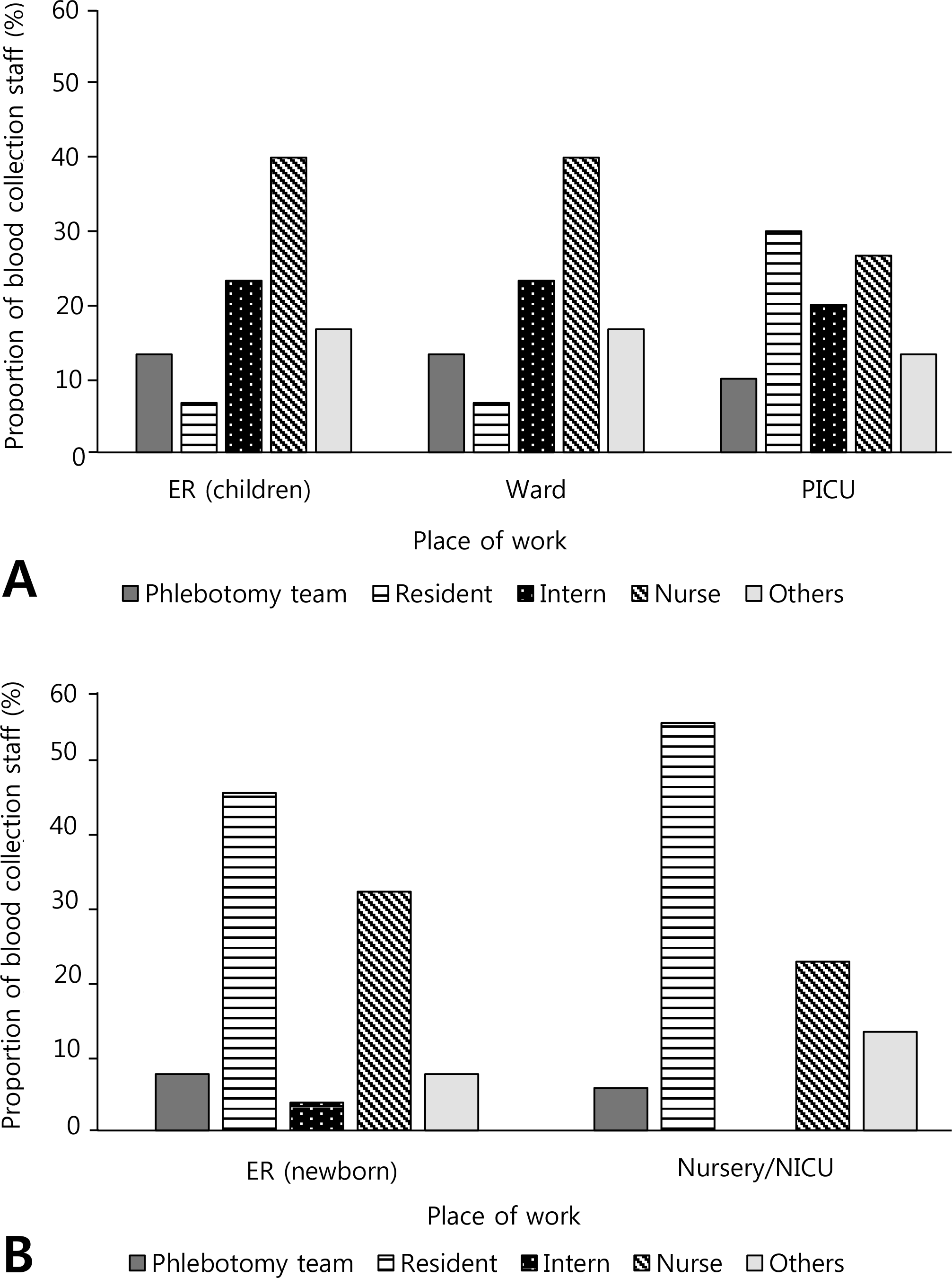Abstract
Purpose
Methods
Results
Conclusions
References
 | Fig. 1.The job roles of the staff that collect blood from patients were compared among different places of work. (A) Staff who performed blood culture in child patients in the pediatric emergency room (ER), the ward, and in the pediatric intensive care unit (PICU). A total of 30 pediatric infectious disease specialists responded to the survey. (B) Staff who performed blood culture in neonates in the nursery, the neonatal intensive care unit (NICU), and in the ER. A total of 52 neonatologists responded to the survey. |
Table 1.
| Variable | Children (n=30)∗ | Neonates (n=52)† | P-value |
|---|---|---|---|
| Obtaining blood cultures as regular blood tests | 10 (33.3) | 31 (59.6) | 0.022 |
| Ordering one set of blood culture in patients with suspected bacteremia | 12 (40.0) | 34 (65.4) | 0.026 |
| Collecting blood from one site puncture for two sets of blood cultures | 18 (60.0) | 25 (48.1) | 0.960 |
| Collecting blood via venipuncture | 30 (100.0) | 33 (63.5) | <0.001 |
∗ Data was collected from pediatric infectious diseases specialists working in general hospitals or teaching hospitals. They responded to the questionnaire, which contain questions about blood culture for children who were based in the emergency room, ward, or the pediatric intensive care unit.
† Data was collected from neonatologists working in neonatal intensive care units in general hospitals or teaching hospitals. They responded to the questionnaire, which co tained questions about blood culture for neonates who were based in the emergency room, nursery, or the neonatal intensive care unit.
Table 2.
| Variable | Children (n=30) | Neonates (n=52) |
|---|---|---|
| Blood culture procedure | ||
| Disinfection of the rubber septum on the blood culture bottle | 26 (86.7) | 47 (90.4) |
| Type of disinfectants used on the rubber septum on the blood culture bottle∗ | ||
| Povidone-iodine | 9 (34.6) | 19 (40.4) |
| Alcohol | 8 (30.8) | 12 (25.5) |
| Chlorhexidine | 8 (30.8) | 12 (25.5) |
| Chlorhexidine then alcohol | 0 | 3 (6.4) |
| No. of disinfectants used for skin preparation | ||
| One† | 14 (46.7) | 28 (53.8) |
| Two‡ | 15 (50.0) | 21 (40.4) |
| More than three | 1 (3.3) | 3 (5.8) |
| Provider antisepsis method | ||
| Use of sterile gloves | 13 (43.3) | 28 (53.8) |
| Quality control methods | ||
| Transporting the blood culture bottle directly to the continuous-monitoring blood culture instruments | 20 (66.7) | 36 (69.2) |
| Blood culture contamination monitoring | 18 (60.0) | 38 (73.1) |
| Feedback on contamination rate to the provider | 10 (33.3) | 25 (48.1) |
| Regular education on blood culture procedures | 12 (40.0) | 15 (28.8) |




 PDF
PDF ePub
ePub Citation
Citation Print
Print


 XML Download
XML Download